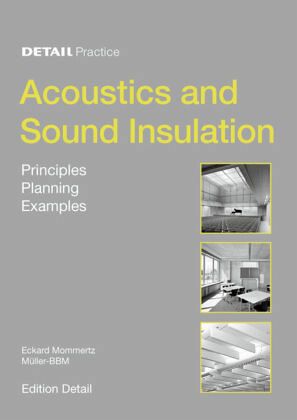Nicht lieferbar

Acoustics and Sound Insulation
Principles, Planning, Examples
Versandkostenfrei!
Nicht lieferbar
Acoustics and protection against noise do not perhaps number among the primary parameters that normally influence the design of a building. Nevertheless, at the very latest when the lecturer in the seminar room cannot be heard, when the noise level in an open-plan office reaches unbearable levels, or when a neighbor’s noise deprives you of sleep, it becomes clear just how essential acoustic can be to everyday well-being. it is not just concert halls or the amphitheaters of antiquity that call for acoustic quality; rather, every building, indeed every room, has an acoustic dimension that changes according to the nature of its particular requirements.
This practice-oriented volume provides expert planners and architects but also interested developers with practical knowledge on the subject of acoustics in high-rise architecture, beginning with standards on methods of planning and prognosis and moving on to the areas of acoustics of rooms and architecture and noise protection in urban planning.
Typologically organized chapters comment on proper approaches to the subject with examples of different types of building such as residential and office buildings, schools, kindergartens, lecture halls, event spaces, and so on, because appropriate acoustic conditions make an essential contribution to the success of a project.
This practice-oriented volume provides expert planners and architects but also interested developers with practical knowledge on the subject of acoustics in high-rise architecture, beginning with standards on methods of planning and prognosis and moving on to the areas of acoustics of rooms and architecture and noise protection in urban planning.
Typologically organized chapters comment on proper approaches to the subject with examples of different types of building such as residential and office buildings, schools, kindergartens, lecture halls, event spaces, and so on, because appropriate acoustic conditions make an essential contribution to the success of a project.
Schallschutz und Akustik gehören vielleicht nicht zu den primären Parametern, die den Entwurf eines Gebäudes normalerweise beeinflussen. Doch spätestens wenn man den Vortragenden im Seminarraum nicht versteht, der Geräuschpegel im Großraumbüro unerträgliche Ausmaße annimmt oder das Rumoren des Nachbars einem den Schlaf raubt, wird klar, wie wesentlich die Raumakustik zum alltäglichen Wohlbefinden beiträgt. Nicht nur Konzertsäle oder das antike Amphitheater erheben Anspruch auf akustische Qualität, sondern jedes Gebäude, sogar jeder Raum besitzt eine akustische Dimension, die je nach Funktion in ihren individuellen Anforderungen variiert.
Der vorliegende Praxis-Band vermittelt allen Fachplanern, Architekten, aber auch interessierten Bauherren praxisnahe Kenntnisse zum Thema Akustik im Hochbau, angefangen von normativen Regelungen über Planungs- und Prognosemethoden bis hin zu den Bereichen Raumakustik, Bauakustik und Schallschutz im Städtebau.
Typologische Kapitel erläutern beispielhaft den richtigen Umgang mit der Thematik an verschiedenen Gebäudearten wie beispielsweise Wohn- und Bürogebäuden, Schulen, Kindergärten, Hörsälen, Veranstaltungsräumen etc. , denn angemessene akustische Bedingungen tragen zum Erfolg eines Projektes massgeblich bei.
Der vorliegende Praxis-Band vermittelt allen Fachplanern, Architekten, aber auch interessierten Bauherren praxisnahe Kenntnisse zum Thema Akustik im Hochbau, angefangen von normativen Regelungen über Planungs- und Prognosemethoden bis hin zu den Bereichen Raumakustik, Bauakustik und Schallschutz im Städtebau.
Typologische Kapitel erläutern beispielhaft den richtigen Umgang mit der Thematik an verschiedenen Gebäudearten wie beispielsweise Wohn- und Bürogebäuden, Schulen, Kindergärten, Hörsälen, Veranstaltungsräumen etc. , denn angemessene akustische Bedingungen tragen zum Erfolg eines Projektes massgeblich bei.













